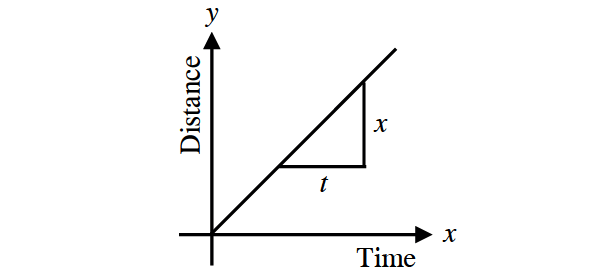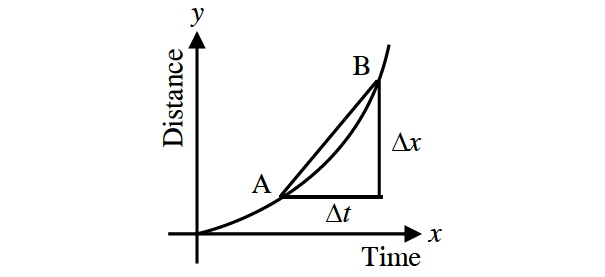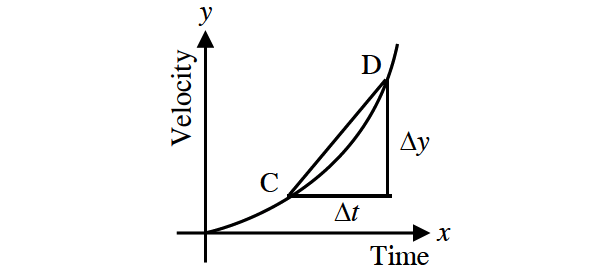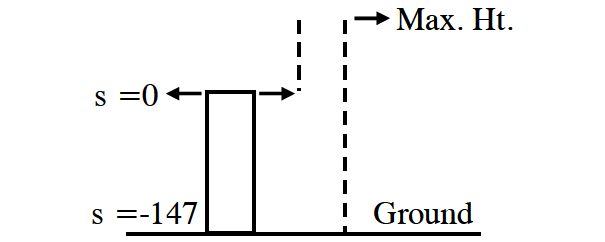VELOCITY AND ACCELERATION
Subscribe to our ▶️ YouTube channel 🔴 for the latest videos, updates, and tips.
A car describes a distance x metres in time t seconds along a straight road. If the velocity v is constant, then
v = ˣ⁄t meter per sec
That is, the slope (gradient) of the distance/time graph shown in the figure below is constant.

If, however, the velocity of the car is not constant then the distance/time graph will not be a straight line. It may be as shown in the figure below.

The average velocity over a small time Δt and distance Δx is given by the gradient of the chord AB. That is, the average velocity over time Δt is
As Δt → 0, the chord AB becomes a tangent, such that at point A the velocity is given by v = ᵈˣ⁄dt. Hence the velocity of the car at any instant is given by gradient of the distance/time graph. If an expression for the distance x is known in terms of time, then the velocity is obtained by differentiating the expression.
The acceleration a of the car is defined as the rate of change of velocity. A velocity/time graph is shown in the figure below.

If Δv is the change in v and Δt is the corresponding change in time, then
As Δt → 0 the chord CD becomes a tangent such that at the point C, the acceleration is given by a = ᵈⱽ⁄dt.
Hence the acceleration of the car at any instant is given by the gradient of the velocity/time graph. If an expression for velocity is known in terms of time t, then the acceleration is obtained by differentiating the expression.
Acceleration a = ᵈⱽ⁄dt, where v = ᵈˣ⁄dt
Hence
The acceleration is given by the second differential coefficient of distance x with respect to time t. The above discussion can be summarised as follows. If a body moves a distance x meters in time t seconds then
(i) distance x = f(t).
(ii) velocity v = f'(t) or ᵈˣ⁄dt, which is the gradient of the distance/time graph.
Note :
(i) Initial velocity means velocity at t = 0.
(ii) Initial acceleration means acceleration at t = 0.
(iii) If the motion is upward, at the maximum height, the velocity is zero.
(iv) If the motion is horizontal, v = 0 when the particle comes to rest.
Solved Problems
Problem 1 :
The distance x metres described by a car in time t seconds is given by :
x = 3t3 - 2t2 + 4t - 1
Determine the velocity and acceleration when (i) t = 0 and (ii) t = 1.5 sec.
Solution :
x = 3t3 - 2t2 + 4t - 1
Velocity :
v = ᵈˣ⁄dt
v = 3(3t2) - 2(2t) + 4(1) - 0
v = 9t2 - 4t + 4
Acceleration :
a = ᵈⱽ⁄dt
a = 9(2t) - 4(1) + 0
a = 18t - 4
When t = 0,
|
v = 9(0) - 4(0) + 4 v = 4 m/s |
a = 18(0) - 4 a = m/s2 |
When t = 1.5 sec.,
|
v = 9(1.5)2 - 4(1.5) + 4 v = 9(2.25) - 6 + 4 v = 20.25 - 6 + 4 v = 18.25 m/s |
a = 18(1.5) - 4 a = 27 - 4 a = 23 m/s2 |
Problem 2 :
Supplies are dropped from an helicopter and distance fallen in time t seconds is given by x
x = (½)gt2
where g = 9.8 m/sec2. Determine the velocity and acceleration of the supplies after it has fallen for 2 seconds.
Solution :
Distance :
x = (½)gt2
x = (½)(9.8)t2
x = 4.9t2
Velocity :
v = ᵈˣ⁄dt
v = 4.9(2t)
v = 9.8t
Acceleration :
a = ᵈⱽ⁄dt
a = 9.8(1)
a = 9.8
When t = 2 seconds,
|
v = 9.8t v = 9.8(2) v = 19.6 m/s |
a = 9.8 a = 9.8 m/s2 |
Problem 3 :
The angular displacement θ radians of a fly wheel varies with time t seconds and follows the equation
θ = 9t2 - 2t3
Determine
(i) the angular velocity and acceleration of the fly wheel when time t = 1 second and
(ii) the time when the angular acceleration is zero.
Solution :
Part (i) :
Angular displacement :
θ = 9t2 - 2t3
Angular velocity :
ω = ᵈθ⁄dt
ω = 9(2t) - 2(3t2)
ω = 18t - 6t2
Angular acceleration :
α = ᵈω⁄dt
α = 18(1) - 6(2t)
α = 18 - 12t
When t = 1 second,
|
ω = 18(1) - 6(1)2 ω = 18 - 6 ω = 12 rad/s |
α = 18 - 12(1) α = 18 - 12 α = 16 rad/s2 |
Part (ii) :
When angular acceleration is zero,
α = 0
18 - 12t = 0
-12t = -18
t = 1.5 seconds
Problem 4 :
A boy, who is standing on a pole of height 14.7 m throws a stone vertically upwards. It moves in a vertical line slightly away from the pole and falls on the ground. Its equation of motion in meters and seconds is
x = 9.8t - 4.9t2
(i) Find the time taken for upward and downward motions.(ii) Also find the maximum height reached by the stone from the ground.
Solution :

Part (i) :
x = 9.8t - 4.9t2
Velocity :
v = ᵈˣ⁄dt
v = 9.8(1) - 4.9(2t)
v = 9.8 - 9.8t
At the maximum height v = 0.
9.8 - 9.8t = 0
-9.8t = -9.8
t = 1 second
So, the time taken for upward motion is 1 second. For each position x, there corresponds a time t.
The ground position is x = -14.7, since the top of the pole is taken as x = 0.
To get the total time, substitute x = -14.7 into the given equation.
-14.7 = 9.8t - 4.9t2
4.9t2 - 9.8t - 14.7 = 0
Multiply both sides by 10.
49t2 - 98t - 147 = 0
Divide both sides by 49.
t2 - 2t - 3 = 0
Factor and solve for t.
t2 - 3t + t - 3 = 0
t(t - 3) + 1(t - 3) = 0
(t - 3)(t + 1) = 0
t - 3 = 0 or t + 1 = 0
t = 3 or t = -1
Time can never be a negative value. So, t = 3.
Already we know that the time taken for upward motion is t = 1 second.
Therefore, the time taken for downward motion is
= 3 - 1
= 2 seconds
Part (ii) :
When t = 1,
x = 9.8(1) - 4.9(1)2
x = 9.8 - 4.9
x = 9.8
The maximum height reached by the stone :
= 14.7 + 4.9
= 19.6 meters
Subscribe to our ▶️ YouTube channel 🔴 for the latest videos, updates, and tips.
Kindly mail your feedback to v4formath@gmail.com
We always appreciate your feedback.
©All rights reserved. onlinemath4all.com
Recent Articles
-
SAT Math Practice
Dec 05, 25 04:04 AM
SAT Math Practice - Different Topics - Concept - Formulas - Example problems with step by step explanation -
10 Hard SAT Math Questions (Part - 37)
Dec 03, 25 07:02 AM
10 Hard SAT Math Questions (Part - 37) -
Factorial Problems and Solutions
Dec 02, 25 09:27 AM
Factorial Problems and Solutions

